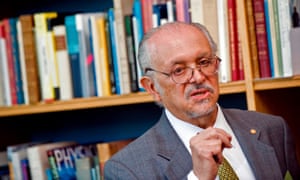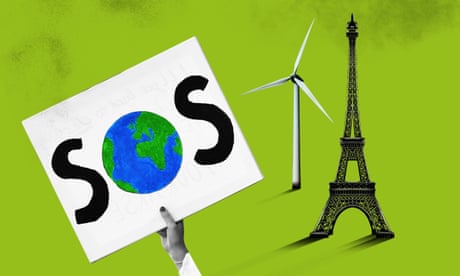Mexican scientist who helped discover dangers posed by CFCs to the ozone layer, leading to an international ban on their use
Fiona Harvey Mon 12 Oct 2020 THE GUARDIAN

Mario Molina’s work was responsible for a global treaty that has helped to reduce the hole in the ozone layer, which should be fully repaired by the 2080s. Photograph: Jonathan Nackstrand/AFP/Getty Images
Unknown to humanity, in the later decades of the last century an environmental crisis was slowly unfolding in the upper atmosphere. The existence of the ozone layer was proved by chemists in the early 20th century, but as a scientific curiosity rather than a cause for concern. A thin layer between the troposphere, in which we live, and the stratosphere, the ozone layer filters out about 99% of harmful ultraviolet light from the sun before it hits the Earth. Exposure to unfiltered ultraviolet light can cause skin cancers, eye damage and weakened immune systems.
What we did not know until the mid 1970s was that chlorofluorocarbons (CFCs), chemicals that had come into widespread use as refrigerant gases and aerosol propellants, were reacting unseen with the ozone layer, fatally thinning the Earth’s protective cloak.

Mario Molina, who has died of a heart attack aged 77, won the Nobel prize for chemistry in 1995, along with F Sherwood Rowland and the Dutch scientist Paul Crutzen, for their work unravelling the impact of CFCs on the ozone layer, and the stark warning they delivered to humanity. Molina and Rowland jointly published a landmark paper in the peer-review journal Nature in 1974 showing the impact of CFCs on ozone.
Despite the strength of their science, it was more than a decade before their work was acted upon, amid protestations from the chemical industry. Nasa at first reported that their data showed no signs of ozone depletion – it was later discovered they were led astray by computer software trained to ignore what seemed anomalous readings. It was only with the work of Joe Farman and colleagues at the British Antarctic Survey in another Nature paper in 1985 that clinching proof was obtained – a vast hole was opening up in the ozone layer over the South Pole.
Unknown to humanity, in the later decades of the last century an environmental crisis was slowly unfolding in the upper atmosphere. The existence of the ozone layer was proved by chemists in the early 20th century, but as a scientific curiosity rather than a cause for concern. A thin layer between the troposphere, in which we live, and the stratosphere, the ozone layer filters out about 99% of harmful ultraviolet light from the sun before it hits the Earth. Exposure to unfiltered ultraviolet light can cause skin cancers, eye damage and weakened immune systems.
What we did not know until the mid 1970s was that chlorofluorocarbons (CFCs), chemicals that had come into widespread use as refrigerant gases and aerosol propellants, were reacting unseen with the ozone layer, fatally thinning the Earth’s protective cloak.

Mario Molina, who has died of a heart attack aged 77, won the Nobel prize for chemistry in 1995, along with F Sherwood Rowland and the Dutch scientist Paul Crutzen, for their work unravelling the impact of CFCs on the ozone layer, and the stark warning they delivered to humanity. Molina and Rowland jointly published a landmark paper in the peer-review journal Nature in 1974 showing the impact of CFCs on ozone.
Despite the strength of their science, it was more than a decade before their work was acted upon, amid protestations from the chemical industry. Nasa at first reported that their data showed no signs of ozone depletion – it was later discovered they were led astray by computer software trained to ignore what seemed anomalous readings. It was only with the work of Joe Farman and colleagues at the British Antarctic Survey in another Nature paper in 1985 that clinching proof was obtained – a vast hole was opening up in the ozone layer over the South Pole.

The discovery was made just in time: at the rate of destruction in the mid-80s, the ozone layer could have been damaged beyond repair in as little as a decade.
Molina was a young chemist, who had barely finished his PhD, when he started working with Rowland on the study of CFCs that would transform his career and avert disaster. Born in Mexico City to Roberto Molina Pasquel, a lawyer and judge who later served as ambassador to Ethiopia, Australia and the Philippines, and Leonor Henriquez, he showed his fascination for the world of science early on. Perhaps influenced by his aunt Esther, a chemist, as a child he set up a mini laboratory in a bathroom at home with toy microscopes and chemistry sets.
He went to boarding school in Switzerland at the age of 11, believing that to speak German was essential for a serious chemist, before returning to high school in Mexico. As he later recalled: “I was disappointed that my European schoolmates had no more interest in science than my Mexican friends. I had already decided to become a research chemist; earlier, I had seriously contemplated the possibility of pursuing a career in music – I used to play the violin in those days.”
After graduating in chemical engineering from the National Autonomous University of Mexico (UNAM) in 1965, Molina went on to study at the University of Freiburg in Germany, and then to a PhD in laser chemistry in 1972 from Berkeley, part of the University of California. He then joined, as a post-doctoral research associate, a group led by Rowland, professor of chemistry at the University of California, Irvine.
In 1972 Rowland had attended a presentation on the work of James Lovelock, a British scientist who had measured traces of CFCs – then thought to be harmless – with instruments he had designed. Rowland realised that CFCs were not likely to be as inert as was thought when found at altitude, and offered this to Molina as a choice among several subjects for research.
“Mario chose the one furthest from his previous experience and from my own experience as well, and we began studying the atmospheric fate of the CFC molecules,” Rowland recounted. “Within three months, Mario and I realised that this was not just a scientific question, challenging and interesting to us, but a potentially grave environmental problem involving substantial depletion of the stratospheric ozone layer. A major part of both of our careers since has been spent on the continuing threads of this original problem.”
While at Berkeley Molina also met Luisa Y Tan, a fellow chemist, who went on to be president of the Molina Center for Strategic Studies in Energy and the Environment at La Jolla, California. They married in 1973 and their son Felipe was born in 1977. The marriage ended in divorce and Molina was married again, to Guadalupe Álvarez, in 2006.
Though he spent much of his working life in the US, including stints as a scientific adviser to President Barack Obama and at the Massachusetts Institute of Technology, Molina continued to act as a figurehead for Mexican science throughout his life, holding a professorship at UNAM. In 2015 UNAM inaugurated the Mario Molina building, a collaboration between industry and research scientists. When his country played host to climate talks in 2010, Molina played a significant role. In his later years the climate emergency became an increasing area of focus, along with air quality and air pollution.
The ozone layer is now recovering, and should be close to full repair by the 2080s, thanks to an international treaty – the Montreal protocol, signed in 1987 – that phased out CFCs. What is less known is that Molina’s work will also help to avert ruin from that other dire emergency, the climate crisis. Some of the substitutes for CFCs held an unrecognised danger: they are powerful greenhouse gases, with the potential to warm the planet at a rate many thousands of times greater than carbon dioxide. Last year the Kigali amendment to the Montreal protocol came into force, phasing out a raft of these chemicals too.
Durwood Zaelke, president of the US-based Institute for Governance and Sustainable Development, who worked with Molina on urging governments to take action on the climate, said: “The Montreal protocol solved the first great threat to the global atmosphere, and has done more to solve the next threat – the climate threat – than any other agreement, including the Paris agreement. Phasing down CFCs and related fluorinated gases has avoided more climate warming than carbon dioxide is causing today. Mario remained deeply involved until his last days.”
He is survived by his wife, his son, three stepchildren, two brothers and a sister and two grandchildren.
• Mario Molina, chemist, born 19 March 1943; died 7 October 2020
No comments:
Post a Comment